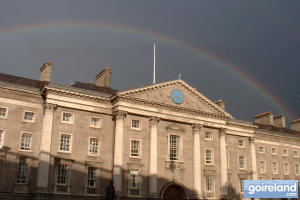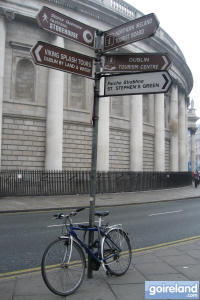 Dublin is a wonderful city steeped in rich history and reflects the past with its many magnificent buildings and monuments. The name Dublin is derived from the Irish name ‘Dubh Linn’ meaning ‘Black Pool’. The common name in modern Irish for Dublin is today called ‘Baile Átha Cliath’ meaning ‘Town of the Hurdled Ford’.
Dublin is a wonderful city steeped in rich history and reflects the past with its many magnificent buildings and monuments. The name Dublin is derived from the Irish name ‘Dubh Linn’ meaning ‘Black Pool’. The common name in modern Irish for Dublin is today called ‘Baile Átha Cliath’ meaning ‘Town of the Hurdled Ford’.
In this article we take a look at a brief history of the city on the Liffey that is - Dublin.
It was approximately 500 BC that The Celts arrived in Ireland and by 200 AD they had built the foundation of what was to become Dublin. Dubh Linn was located where Father Mathew Bridge and Church Street cross the River Liffey today. Over the years many settlements called this crossing their home including the Vikings who arrived in 841 AD and used this shallow pool - River Poddle - to moor their ships.
The Dubh Linn was situated where the Castle Garden is now located, just opposite where Dublin Castle and The Chester Beatty Library stand today. Another small community settled here, a Christian monastic community who thrived here and built a monastery.
Dublin was ruled by The Vikings for most of the time between 841 and 999, during these times The Vikings played havoc in Ireland raiding wealthy monasteries throughout Ireland and extending their settlements making them the first to establish the very first towns in Ireland. The Vikings also erected a stockade or a defensive wall around Dubh Linn to protect them from attack.
With the arrival of the Anglo-Normans to the gates of Dubh Linn in 1170 everything changed. The Vikings were forced to move to the far side of the river where they set up their own town called Ostmantown: meaning ‘The Town of the Men from the East’, and the native Irish were also chased off to their own settlements.
English settlers soon followed the Anglo-Normans and for the best part of 750 years Dublin and Ireland were ruled by the parliament of England. The Irish Chieftains continued to fight for Dublin but were unsuccessful in their attempts. Castles and towers sprung up all over Dublin City and further defensive walls were built. In 1592 Irelands Trinity College was erected, this marked the expansion of Dublin.
 During the 17th Century Dublin began to mould into a wonderful town with boulevards, squares, grand houses, mansions and gardens. The Four Courts, Leinster House and Custom House were built during these times.
During the 17th Century Dublin began to mould into a wonderful town with boulevards, squares, grand houses, mansions and gardens. The Four Courts, Leinster House and Custom House were built during these times.
Not far from these masterpieces was another story, a story of poverty and hardship. Ruled by English Rule and by English landlords, poverty was to continue throughout Dublin and Ireland for a long time to come.
In the 1840′s more hardship was to follow, something that would change Ireland and its people forever - the arrival of The Great Famine - This brought terrible devastation and took over one million lives and as many, if not more people emigrated boarding ‘The Coffin Ships’ as they were referred to for a new and better life. Many did not make the journey and those that were successful were never to return again. This devastation was to continue over the next century.
In 1916 more changes were to come and a Rising, The Easter Rising broke out which saw the men and women of Ireland take on British troops and fight for Ireland’s independence. This Rebellion saw large parts of Dublin destroyed but in the midst of the rubble, Ireland was to change forever.
Between 1919 and 1921 The War of Independence brought a Truce, this resulted in the British withdrawing from the southern 26 counties. Dublin City saw further destruction during the Civil War - this Civil War established the Irish Free State. Dublin and Ireland suffered badly in the aftermath of The War of Independence and The Civil War but over the years Dublin would re-build itself.
During the 1960′s boom many buildings in Dublin were demolished in haste instead of being restored and others put in their place! During the late 1980′s Dublin’s city’s heritage was finally appreciated and thankfully those that survived the test of time were renovated to their original glory and can be seen and admired throughout the city today.
Today Dublin is a thriving cosmopolitan city rich in History, Literature, Art, Music and Theatre and offers a wealth of attractions. It is easy to see why Dublin welcomes over four million visitors to its city each year!
There are many reminders of times past in the City once called ‘Dubh Linn’ with its magnificent churches, historic buildings, museums, monuments, gardens and city streets. So come on, visit the city on the Liffey called Dublin - a city that has finally discovered its own identity.
Need accommodation? Find and reserve Dublin hotels and book securely online today.
Have you visited the historic city of Dublin? Why not share your experience with our readers? As always we would love to hear from you. Please feel free to leave a comment in the comment box below. Thank you.
